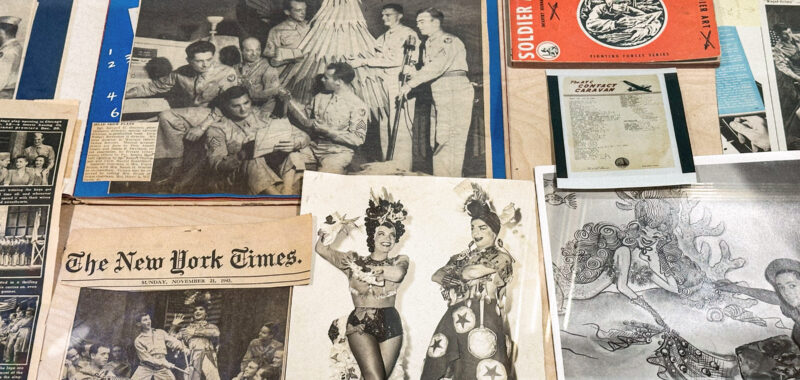SYRACUSE, New York — It’s the middle of World War II, and Sergeant Sascha Brastoff, a designer and performer with the United Service Organizations, is all dolled up, swaying his hips as his drag alter ego, GI Carmen Miranda, to cheers from his fellow troops. Sporting a headpiece made from a hand broom, a dented canteen, a duffle bag, and numerous forks wired together, Brastoff, who was drafted in 1942, carved a unique groove for himself as an enlisted noncombatant — one that led to elite Hollywood circles, icon status in and beyond Los Angeles’s queer underground, and success as a commercial porcelain designer. In a time when queerness was taboo, Brastoff leveraged his flamboyant tastes to build a career on style, camp, and influential connections.
Currently on view at the Everson Museum of Art in Syracuse, Sascha Brastoff: California King is the artist’s first solo museum retrospective. Focusing on ceramics, and bolstered by substantial loans from collector David Newmarket and biographer Steve Conti, the exhibition demonstrates the range of Brastoff’s artwork and presents his biography through text panels, personal photographs, videos, and other ephemera. These include elaborate dance and drag costumes; decorative, often gilded images of animals; Biblical and mythological imagery; and erotic human/sea creature chimeras with multiple breasts, testicles, and protracted phalluses.

Brastoff had a knack for being in the right place at the right time and acquiring new skills accordingly. His USO days led to work as a performer and costume designer for 20th Century Fox, where he befriended the real Carmen Miranda. After acquiring custom ashtrays from Brastoff, Winthrop Rockefeller (grandson of John D.) financed the artist’s mid-century porcelain housewares factory, Sascha Brastoff, Inc. Brastoff also pursued metal sculpture, some of which became set decorations in the 1956 sci-fi classic Forbidden Planet. Towards the end of his life, he collaborated with jewelry designer Marilyn Watson to make gold-electroplated costume jewelry. All these various phases are represented in California King.
The small gallery is jam-packed with Brastoff’s artworks in multiple media and ephemera from a period between about 1940 and the mid-1980s; the show could easily have been expanded into another gallery and perhaps should have. The initial impression is dazzling to the point of overwhelming, but this crowded menagerie of objets d’art fits Brastoff’s often over-the-top aesthetic and evidences the enthusiasm of his devotees. As a renewed appreciation of his work grows, the potential for a future Brastoff exhibition that includes some of his costumes (not just the designs) and large-scale sculptures is an exciting prospect.


Sascha Brastoff: California King continues at the Everson Museum of Art (401 Harrison Street, Syracuse, New York) through December 29. The exhibition was organized by Garth Johnson.

